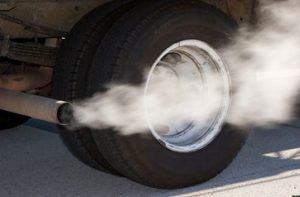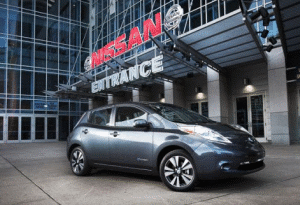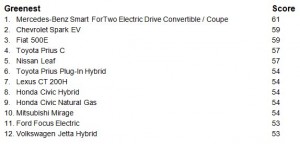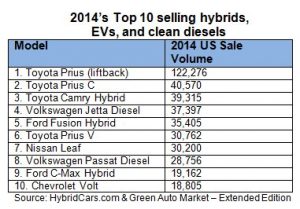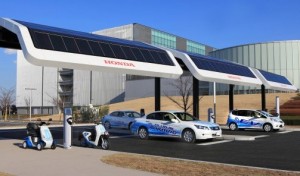by Jon LeSage, editor and publisher, Green Auto Market
Here’s my take on the 10 most significant and interesting occurrences during the past week…….
 Keynote speakers announced for ACT Expo: Gladstein, Neadross and Associates, organizers of the Alternative Clean Transportation (ACT) Expo, announced the speaker lineup for the 2015 conference to be held May 4-7 in Dallas. Keynote presentations will be made by Gregg Rogen, SVP, productivity and sustainability, Frito-Lay; and David Steiner, president and CEO, Waste Management. Frito-Lay in its fleet has nearly 300 electric trucks, more than 200 CNG-powered trucks, more than 650 hybrids, and a growing number of propane autogas and biodiesel vehicles. Waste Management operates the largest fleet of heavy-duty trucks in North America, and Steiner will talk about the company’s investment in alternative fuels and infrastructure. Other speakers during the conference include Boone Pickens, founder, chairman and CEO, BP Capital; Mike Whitlatch, vice president, global energy and procurement, UPS; Elizabeth Fretheim, director of logistics sustainability, Walmart; and Drew Cullen, senior vice president of fuels and facilities services, Penske Truck Leasing. View the event’s full agenda here.
Keynote speakers announced for ACT Expo: Gladstein, Neadross and Associates, organizers of the Alternative Clean Transportation (ACT) Expo, announced the speaker lineup for the 2015 conference to be held May 4-7 in Dallas. Keynote presentations will be made by Gregg Rogen, SVP, productivity and sustainability, Frito-Lay; and David Steiner, president and CEO, Waste Management. Frito-Lay in its fleet has nearly 300 electric trucks, more than 200 CNG-powered trucks, more than 650 hybrids, and a growing number of propane autogas and biodiesel vehicles. Waste Management operates the largest fleet of heavy-duty trucks in North America, and Steiner will talk about the company’s investment in alternative fuels and infrastructure. Other speakers during the conference include Boone Pickens, founder, chairman and CEO, BP Capital; Mike Whitlatch, vice president, global energy and procurement, UPS; Elizabeth Fretheim, director of logistics sustainability, Walmart; and Drew Cullen, senior vice president of fuels and facilities services, Penske Truck Leasing. View the event’s full agenda here.- February plug-in sales. The Nissan Leaf took a narrow lead over the Tesla Model S in February’s US market sales – 1,198 for the Leaf versus 1,150 for Model S. Coming in at third was the BMW i3 with 1,089 units sold. The Chevrolet Volt continues to follow farther behind the Leaf and Model S with 693 units sold. Consumers might be looking forward to the all-new 2016 Volt coming out later this year. Overall US plug-in sales were down 80 units from January and February 2014.
- Oregon testing road-usage program. Oregon and several other states are worried about losing tax revenue due to more plug-in electric and fuel-efficient vehicles entering their roads. So, Oregon is starting a test program staring July 1 where 50,000 registered vehicle owners will participate. Participating drivers will still pay the gas tax at the pump, but at the end of each month, mileage and fuel-consumption data from on-board diagnostics will be used to compare gas tax with a 1.5 cent-per-mile tax that would be charged under a road-usage charge. More than 10 states are in the process of drafting legislation for similar programs or test projects.
- Volkswagen AG is working hard at becoming the top vehicle seller in the world and the industry’s technology leader, CEO Martin Winkertorn said during a Geneva Motor Show news conference. The automaker is debuting the Sport Coupe Concept GTE at the show as an example of technology innovation. The sports coupe has a plug-in hybrid drive system that pairs a 3.0-liter V-6 with two electric motors. In the European test cycle, the car gets a 118 mpg fuel economy rating.
- California approves DME as a vehicle fuel. California’s Division of Measurement Standard’s issued a formal approval to Oberon Fuels for its dimethyl ether (DME) as a vehicle fuel, which will help with the fuel’s commercialization. “The State of California’s approval builds upon the growing body of certifications that demonstrate DME is a low carbon fuel that meets both industry standards for performance and environmental standards for compliance,” Oberon Fuels president Rebecca Boudreaux said.
- Kia pleased with Soul EV sales. Stronger-than-expected customer interest has inspired Kia to accelerate its roll-out plan. It’s the first electric car Kia has sold outside of Korea, and wants to make sure its suppliers, distributors, and dealers are ready in the US. The Soul EV first went on sale in October in California, with plans to expand to Oregon and a few East Coast markets later. The company hopes to announce a plan in April that will include wider availability than had been originally planned.
- Audi reveals plug-in offerings: Audi, which previously had only offered a plug-in hybrid option for its A3 compact car, now has two more plug-ins coming up. Audi will offer its Q7 sport-utility vehicle with two plug-in hybrid powertrains: a diesel option for Europe and a gasoline version for the U.S. and China. Audi has also announced that it will offer a battery electric version of its newly redesigned sports car, the R8 e-tron. The sports car will be able to travel about 280 miles on a single charge.
- More clean fleet vehicles: Four vehicle roll-outs sound good for fleets interested in bringing in more alt-fuel vehicles. Motiv Power Systems is launching a battery electric drive compatible with the Ford F59 chassis and has received an initial order for six vehicles for AmeriPride in Fresno, Calif. BioCNG will be upgrading a landfill gas-based compressed natural gas fueling station for the St. Landry Parish Solid Disposal District in Louisiana; and will be adding a second facility at the District’s recycling center in Opelousas. Coca-Cola has converted 39 GM Express vans to hybrid electrics using XL3 systems from XL Hybrids. It’s tied into an executive order last year by the California Air Resources Board and brings Coke’s total number of XL Hybrid-fitted vans up to 211. Efficient Drivetrains, Inc. (EDI) has announced the availability of a Class 3 utility plug-in hybrid truck. EDI says that it features an extended range of 300 miles and 50-to-120 kW of grid reliable export power.
- Two 350Green executives face fraud charges. Mariana Gerzanych and Timothy Mason – the two former top ranking executives of electric vehicle charging station supplier 350Green – have been accused in a federal court of falsely obtaining almost $3 million in grant money for a project, The Chicago Tribune reported. 350Green had been working with the city of Chicago to install its charging network. Gerzanych and Mason have been charged with obtaining funds by falsely claiming they’d paid subcontractors and vendors for work on the charging stations.
- Tesla cutting jobs in China. Tesla Motors Inc. may be reducing its staff by 30% in China as it makes structural changes in the market. The Chinese newspaper Economic Observer reported Tesla will eliminate 180 of the 600 positions in China because sales haven’t met expectations.

